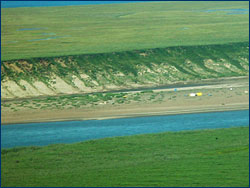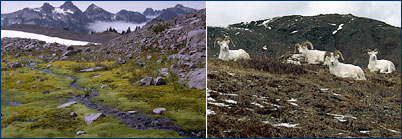 Tundra along the Colville River, Alaska. |
Characteristics of tundra include:
- Extremely cold climate
- Low biotic diversity
- Simple vegetation structure
- Limitation of drainage
- Short season of growth and reproduction
- Energy and nutrients in the form of dead organic material
- Large population oscillations
Tundra is separated into two types:
- Arctic tundra
- Alpine tundra
 From left: tundra near Churchill, Manitoba, Canada; tundra in the Arctic National Wildlife Refuge, Alaska. |
- low shrubs, sedges, reindeer mosses, liverworts, and grasses
- 400 varieties of flowers
- crustose and foliose lichen
All of the plants are adapted to sweeping winds and disturbances of the soil. Plants are short and group together to resist the cold temperatures and are protected by the snow during the winter. They can carry out photosynthesis at low temperatures and low light intensities. The growing seasons are short and most plants reproduce by budding and division rather than sexually by flowering. The fauna in the arctic is also diverse:
- Herbivorous mammals: lemmings, voles, caribou, arctic hares and squirrels
- Carnivorous mammals: arctic foxes, wolves, and polar bears
- Migratory birds: ravens, snow buntings, falcons, loons, sandpipers, terns, snow birds, and various species of gulls
- Insects: mosquitoes, flies, moths, grasshoppers, blackflies and arctic bumble bees
- Fish: cod, flatfish, salmon, and trout
Animals are adapted to handle long, cold winters and to breed and raise young quickly in the summer. Animals such as mammals and birds also have additional insulation from fat. Many animals hibernate during the winter because food is not abundant. Another alternative is to migrate south in the winter, like birds do. Reptiles and amphibians are few or absent because of the extremely cold temperatures. Because of constant immigration and emigration, the population continually oscillates.
 From left: alpine tundra in Mt. Rainier National Park, Washington; Dall Sheep in the Arctic National Wildlife Refuge, Alaska. |
- tussock grasses, dwarf trees, small-leafed shrubs, and heaths
Animals living in the alpine tundra are also well adapted:
- Mammals: pikas, marmots, mountain goats, sheep, elk
- Birds: grouselike birds
- Insects: springtails, beetles, grasshoppers, butterflies
No comments:
Post a Comment